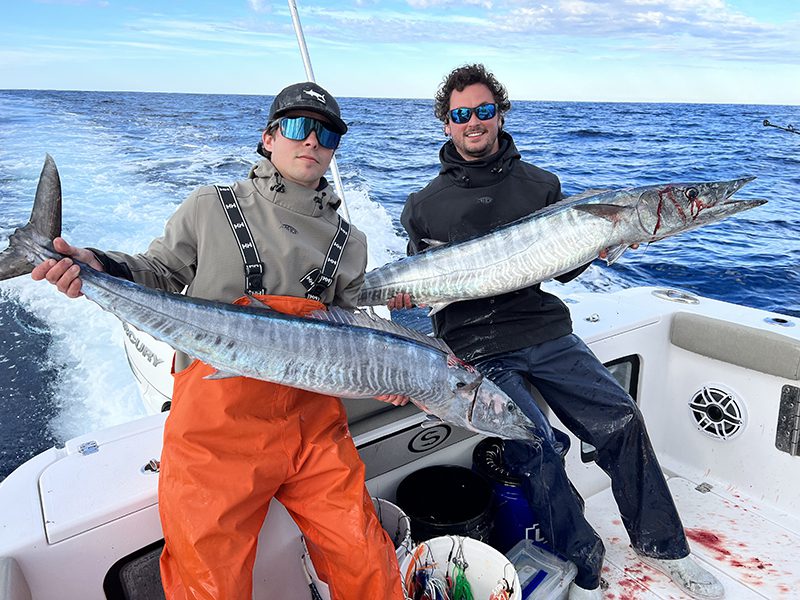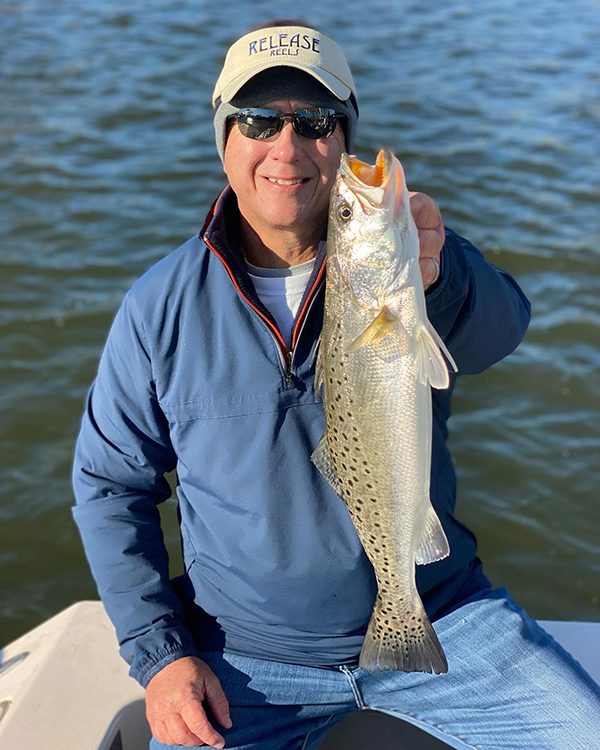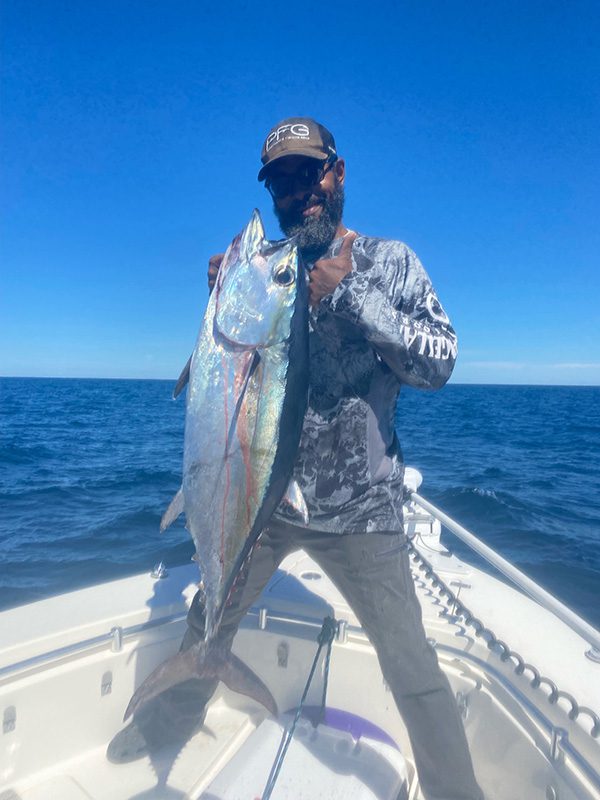Morehead City/Atlantic Beach – December 2022
Nick, of Chasin’ Tails, reports that anglers doing some bottom fishing in the deeper Beaufort Inlet and port areas have been having plenty of success finding a mixed bag of sea mullet, gray trout, pufferfish, and bluefish.
The area’s bridges and rock structures (including the Cape Lookout jetty) are holding some sheepshead.
Anglers working back in the marshes are picking away at groups of red drum and mixed speckled trout.
Speckled trout fishing in particular has really been picking up with the cooler inshore waters now being prevalent. These schools are staged up in holes both in the marshes and back into mainland creeks. This early winter trout fishery is special in that it allows anglers to have success casting a wide variety of baits, as these fish tend to feed aggressively when you locate them. Any mix of MirrOlures, soft plastics with lighter jig heads, and live baits have all provided positive results.
Fishing nearshore, anglers have found the king mackerel fishing a bit spotty as the schools are pushing more offshore with cooler beachfront water temperatures.
A few bluefin tuna are already being spotted within the 10-mile range.
Offshore fishing has been very dependent on the availability of weather windows to make the long runs, but wahoo and blackfin tuna are out there and will stick around most of the winter.

Gage Felton and Reeves Felton, of Emerald Isle, landed these wahoo while trolling a red and black Fathom Torpedo Lantern and a cowbell lure near The Rise.
Joe, of Carolina Traditions Guide Co., reports that anglers running off beach are finding some good king mackerel action, as well as triggerfish when dropping down to structure in the 80-100’ range.
The false albacore run has been unpredictable this season, but anglers can find success by running out along the beaches and shoals around Cape Lookout and throwing metal jigs or flies at the surface-feeding schools.
Nearshore structures off the beach in 20-50’ of water are holding gray trout.
Deeper holes from the inlet back to the Turning Basin have been producing some nice action for anglers doing a bit of bottom fishing. There has been Virginia and Gulf mullet, gray trout, and nice-sized pufferfish.
Red drum are being caught both back in the marshes and by running out on the beachfronts over to the Cape Lookout jetty. Moving into winter, the water clarity keeps cleaning up and provides anglers a great opportunity to sight-cast to these larger schools.
The inshore action also includes flounder and good-sized black drum (to 7 lbs.), with even larger black drum (to 15 lbs.) mixed in.
Speckled trout fishing has been steady, but wind patterns have made it difficult to lock down any sort of consistent bite as the schools move through and into the area. Moving forward, more northern wind patterns will help stabilize the trout fishing as they school up tighter and stage up for the winter.
Daniel, of On Deck Fishing Charters, reports that red drum are still in the backwaters feeding on what’s left of the shrimp.
Speckled trout have started to become more active. A popping cork rigged with live shrimp has been the best producing tactic and also entices some action for the black drum scattered in the area. If fishing artificials, a Gulp shrimp rigged on 1/4 oz. jig heads and bounced along the bottom can also get the trout to bite.
Anglers bottom fishing around nearshore structure are catching some bluefish and gray trout with Thing-a-Ma Jigs and Sam’s Gitter Rigs tipped with shrimp. These areas and deeper holes inside the inlet will also produce sea mullet and spot.
As winter moves in, anglers will continue to find success targeting rock jetties and deeper structures with the jigs or Sam’s Gitter Rig setups. This tactic will produce gray trout, black drum, and some sheepshead.
Speckled trout will be a main inshore target, with lighter jig heads (1/8-1/4 oz.) rigged with Gulp shrimp, Billy Bay shrimp, or MirrOlure MR-17s producing the best chance of filling a limit.

Greg Morris caught this 22″ speckled trout on live shrimp along the ICW near Moreahead City. He was fishing with Capt. Chris Kimrey of Mount Maker Charters.
Chris, of Mount Maker Charters, reports that inshore anglers have seen speckled trout, red drum, black drum, and sheepshead now settled into their respective early winter patterns. These fish are transitioning and are being found anywhere from the jetties to the ICW and in mainland creeks.
The speckled trout and redfish are being caught with soft plastics, hard suspending plugs, and Vudu shrimp.
Nearshore action has been a bit hit-or-miss on the false albacore, but the nearshore reefs and deeper areas around the inlet are holding good numbers of bluefish and gray trout.
Further off the beach in the 70-125’ depth range, there are king mackerel, sharks, amberjack, cobia, and a few blackfin tuna. Any live bottom, ARs, or wrecks in that range can be productive.
Bottom fishing these deeper structures has been producing gag grouper, black sea bass, triggerfish, vermilion snapper, and more.
Moving into winter, the giant bluefin tuna should make their typical showing.
Byron, of Going Bogue Outdoors, reports that bottom fishing out in the 20 fathom range has been excellent and the action should continue as long as water temperature will hover over that 65 degree mark. These bottom fishing trips have been producing a nice mixed bag of triggerfish, large gag grouper, and vermilion snapper.
Gag grouper are currently pushed in more shallow and nearshore as they go through their pre-spawn pattern. These grouper will be holding with fish of similar sizes, meaning if you are finding a bunch of short fish, the chance of a larger grouper in them are slim.
Wahoo are stacked up out in the deeper Gulf Stream waters, but anglers live baiting in water temperatures to 69 degrees will continue to hook fish much closer to home.

Flip Wilson with a 24.25 lb. blackfin tuna caught in 110′ of water using a Yo-Zuri topwater. He was fishing out of Beaufort Inlet with Capt. Chris Falcone of Spooled Rotten Charters.
Bri, of Oceanana Pier, reports that anglers have been catching a bunch of pufferfish while rigging bottom setups with Fishbites and cut shrimp.
There have been some little runs of speckled trout on the beginning pushes of incoming and outgoing tides, and scattered bluefish are mixed in the counts.
